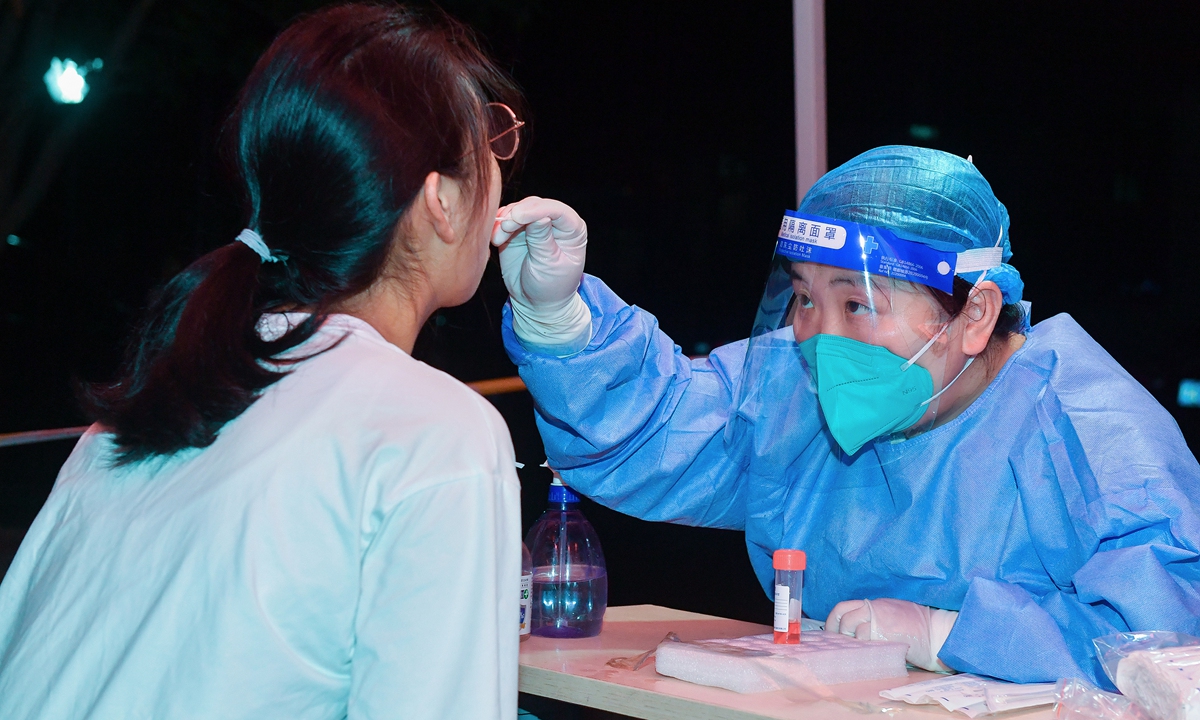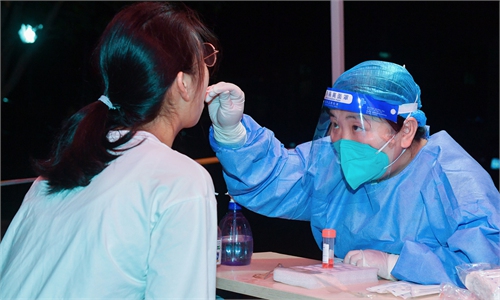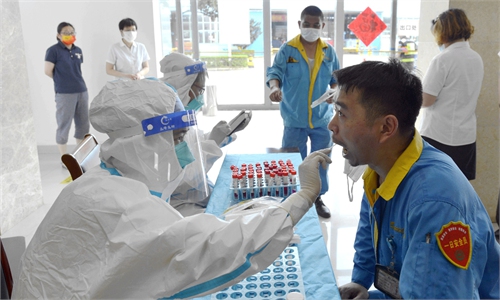China faces challenges posed by new resurgences, links with policy adjustment dismissed
New spike unlikely links to recent adjustments of anti-epidemic policy: experts

A resident from Hefei, capital of East China's Anhui Province, takes nucleic acid testing on June 27, 2022. Photo: IC
The Chinese mainland reported 385 positive COVID-19 infections on Saturday, scattered across seven provincial-level regions, with East China's Anhui the hardest-hit province.The latest resurgence led some to question if the rebound will force officials to adjust anti-epidemic measures to be "stricter," just days after the country shortened quarantine for close contacts and removed an asterisk for high-risk travelers in the country's travel history checking system.
Health experts reached by the Global Times believed that occasional flare-ups are inevitable as long as coronavirus exists, and that there are no signs the current round was caused by recent anti-epidemic policy adjustments. As long as the country's dynamic zero-COVID policy is well implemented, regionalized COVID-19 rebounds should be contained quickly and a broad scale outbreak remains unlikely, they said.
East China's Anhui Province reported a COVID-19 spike on Saturday with 61 confirmed cases and 231 asymptomatic cases being detected, the largest number of daily infections among all affected regions.
The severest-stricken area in Anhui Province is Sixian county which rolled out its sixth round of mass nucleic acid testing on Sunday after a record high daily infections on Saturday - 60 confirmed and 228 asymptomatic cases, local authorities announced.
The county recorded 234 new infections including 20 confirmed cases on Sunday, according to local authorities.
Residents in Sixian county were told to stay indoors so as to cut off viral transmission after COVID-19 infections were discovered on June 26.
But the challenges facing Sixian remain high, an official from the provincial anti-epidemic command center told Chinese media. The official said that the source of the latest spike is unclear and the scale of outbreak is still yet to be determined.
At least three cities - Nanjing, Xuzhou, Wuji in East China's Jiangsu have identified COIVD-19 cases believed to be linked to Anhui's Sixian county.
Outside of Anhui, East China's Shandong, Jiangsu, Zhejiang and Northwest China's Shaanxi and Northeast China's Liaoning, as well as Shanghai reported new infections, according data released by National Health Commission on Sunday.
The fresh flare-up comes days after a recent adjustment made by health authorities - determining that quarantine time for close contacts of COVID-19 infected patients and international arrivals will be reduced from 14 days of centralized quarantine and another seven days of home health monitoring to seven and three days respectively, in addition to the suspension of marking cities with areas with elevated COVID-19 infection risk.
A senior expert from Chinese Center for Disease Control and Prevention told the Global Times on Sunday that no evidence has shown those newly discovered cases have anything to do with the recent adjustments.
A Beijing-based respiratory expert surnamed Wang explained the above adjustments do not mean China has relaxed its anti-epidemic measures, and is not walking away from its dynamic zero-COVID policy, which has safeguarded the country from major outbreaks since 2019. The measures are more precise and scientifically-based, Wang stressed.
As long as COVID-19 has yet to be eliminated and the outbreak overseas in other countries continues to spread, epidemic rebound is normal and inevitable, experts said.
The possibilities of this fresh regional outbreak to develop into a country-wide outbreak is low if the dynamic zero-COVID policy is well implemented across COVID-19 affected regions, with an emphasis on the "four early" practice - early identification, early reporting, early confirming and early quarantine, Wang said.
The expert from China's CDC said he found no reason to further adjust the current anti-epidemic settings to become more "strict," as some have called it. The future of COVID-19 polices will always be based on the evaluation of epidemic situation and the features of mutated variants.
Jiangsu Province reported the second highest number of daily infections on Saturday, after Anhui, with at least six cities within the province had found positive cases.
In response, the Wuxi city government announced late Saturday that it had suspended buses and closed businesses in addition to large public venues and tourist attractions. Restaurants stopped offering dine-in services. The city screened out 31 positive cases on Saturday.
Xuzhou reported 13 positive cases, and imposed strict control measures on high-and medium-risks regions. Outside high-risk regions, residents can still move around and businesses continue to operate normally.
Residents both in Xuzhou and Wuxi are encouraged to remain in place and must present a negative testing certificate taken within 48 hours if they decided to leave the city for essential travel.
Affected by the latest spike, Yiwu temporarily suspended all flights to Beijing starting from Sunday after the city, known as the world's largest wholesale market, recorded two asymptomatic cases on Saturday linked to positive cases from another province.




